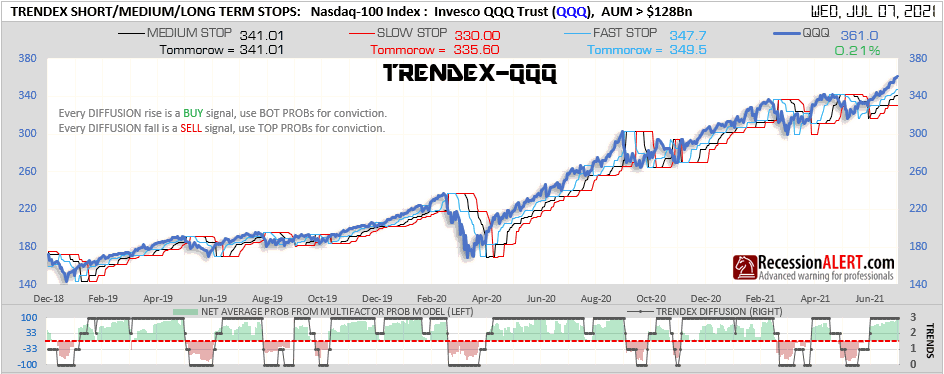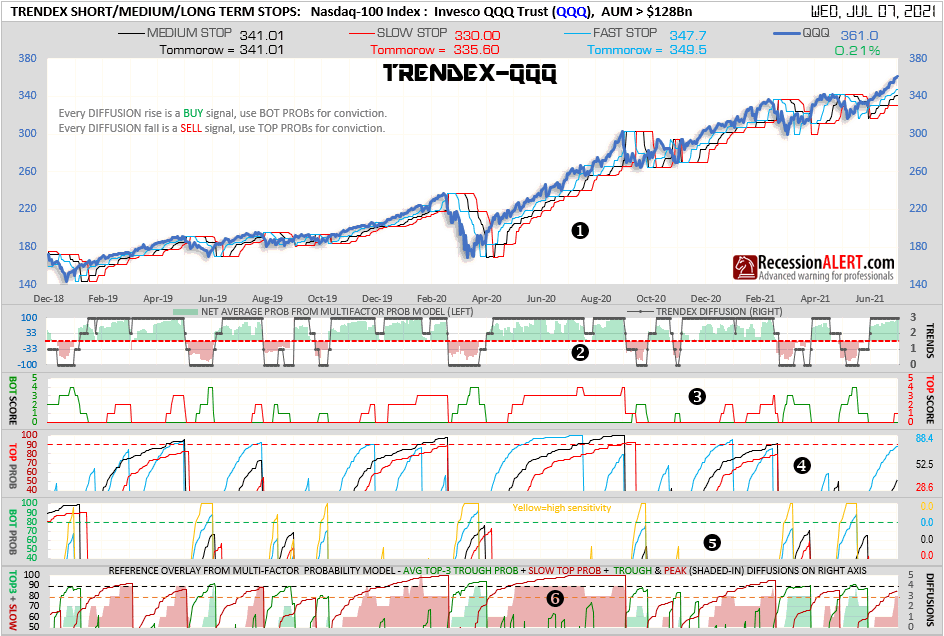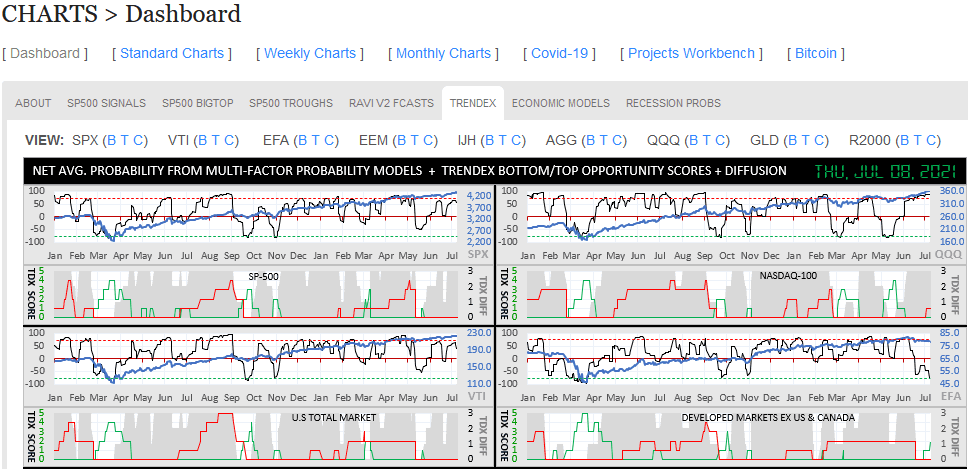1. Introduction
The Trendex indicators are a suite of proprietary short, medium and long term market timing trailing stops with accompanying market peak & bottom probabilities to allow market participants to minimize as well as assess risk or opportunity for nine of the most popular U.S ETF’s commonly used in diversified portfolios.
The Trendex indicators consist of the following components:
- A set of short, medium and longer-term trailing stops for both longs (uptrends) and shorts (downtrends)
- Corresponding probabilities of a market top (uptrends) or market bottom (downtrends)
- A market timing diffusion index.
The Trendex Dashboard combines the above together with two reference market top/bottom probabilities and a diffusion index taken from a Multi-Factor Probability Model for said security/index to compute a final risk/opportunity score to allow a market participant to assess overall risk.
This allows a market participant operating on either short, medium or long-term horizons to have appropriate stop-levels regardless of trend direction, as well have access to an extra dimension of conviction should the stops be breached. Situations where a short-term stop is breached on an established uptrend with an associated low probability/score of a market top may thus be ignored by the trader whilst those stop violations where probabilities exceed 90% only may be acted upon. This is a unique aspect of Trendex over traditional one-dimensional technical indicators/stops.
2. Trendex Stops
These are end-of-day stops based on established levels of strong support (uptrends) or resistance (downtrends) that have been optimized (least number of whipsaws) to reflect behavior of the security/index over the last 15-20 years (depending on how much price history is available). Thus, the long-term daily-close pricing history stretching over at least one full business cycle is used to determine short, medium and long-term stops that best capture short, medium and long-term up/down trends of the security/index.
Below is an example taken from the 1st chart in the SP500 Trendex dashboard. The security is shown together with the 3 stops. Note how the security trades below the resistance-stops in downtrends and above the support-stops in uptrends. Stop levels for the prior days’ close (depicted by the date on top right) is shown together with what the stops will be the following trading day assuming they won’t be violated.
Note that when a long/uptrend support-stop is violated, it immediately turns into a short/downtrend resistance-stop, and vice versa. The provision of stops for the following day allows for advance information for the trader to be able to adjust stops on their trading system should they change from the prior day.
These are end-of-day close stops as opposed to intraday stops, so to follow the models as close as possible it is suggested you try limit your execution toward a few minutes before the closing auction.
3. Models Provided
Due to the long-term optimization required to establish the best performing stops, and the detailed statistical work required to determine accompanying probabilities, it takes time to build Trendex models for specific securities or indices. To this end we have focused our efforts on building models for the most popular, liquid and largest (by assets under management) ETF’s available in the U.S that would be suitable for diversified portfolio purposes. These are the Trendex models currently available for subscribers:
- SP-500 (use any ETF such as SPY, VOO or IVV)
- Nasdaq-100 (model uses QQQ)
- Total U.S Market : 4,000 mega, large, small & micro caps (model uses VTI)
- Developed markets excluding U.S and Canada (model uses EFA)
- Large and mid-cap Emerging Market Equities (model uses EEM)*
- S&P U.S Midcap-400 index (model uses IJH)*
- U.S Aggregate Bond Market (model uses AGG)*
- Russell-2000 small-cap index (model uses IWM)
- Physical Gold (model uses SPDR GLD)
Models tagged with an asterisk are still under development for Trendex but do have multifactor probability models active.
Model-1 is available in the standard subscription whilst models 2-9 are available to PRO subscribers only.
4. Trends Panel
This is the second panel available directly under the main chart. It consists of two indicators as depicted in the QQQ example below
The solid line is the Trendex Diffusion which merely counts how many of the Trendex stops the equity/index is trading above. It is represented by the right axis and ranges from zero (equity/index trading above none of the stops) to 3 (equity/index trading above all 3 stops).
The green/red shaded indicator is the net average probability taken from the equity/indexes’ corresponding multifactor probability model, and represented by the left axis. This is merely the average market top probability less the average market bottom probability. If top probabilities exceed bottom probabilities from the multifactor model then this indicator is positive (green) and we can deem the equity/index to be in a medium-term uptrend. Similarly, if it is negative (red) we can deem the equity/index to be in a medium-term downtrend.
The Trendex Diffusion and the Net Average Probability are shown on the same panel since they both closely represent medium-term trends of the equity index. Since they are computed from completely different variables/methodologies it is interesting for the market participant to observe if they are confirming each other. Furthermore, when one signals a change in direction it can be an early warning that the other is soon about to follow.
When the diffusion in panel-2 rises from zero to higher, these are excellent “buy-the-dip” signals. The higher the corresponding market bottom score as depicted by panel-3 (discussed later), the better your opportunity.
Some traders elect to use the Trendex diffusion to stagger their position sizes in the market. When the diffusion is 3 they are “all in” with 100% allocation and each time it falls by one they may elect to remove a third of their positions into cash. Similarly, each time the diffusion rises, they may elect to add another one third of resources into the market.
5. Trendex Probabilities Panel
Panel-4 (market TOP) and panel-5 (market BOTTOM) depict Trendex stop market-top (peak) and market-trough (bottom) probabilities respectively, as shown with the QQQ example below:
- Blue lines and numbers on right of panel represent the fast-stop implied probabilities
- Black lines and numbers on right of panel represent the medium-stop implied probabilities
- Red lines and numbers on right of panel represent the slow-stop implied probabilities
The function of the probabilities are to add an extra dimension of conviction to the Trendex stops, by depicting how far “stretched” the current up- or down-trend is. Using these we may elect to only act upon stop violations when things are “very stretched” as by definition these are much more rare events and have a higher assumed likelihood of success.
The probabilities are calculated as follows. Each trading session that the equity/index remains above/below a Trendex stop, we add one to the trend count. If the stop is violated, the trend count for the current direction stops and we start a new count for the opposite trend direction. Each day the trend counts are compared to the 15-25 year history (depending how much history we have) to see how often larger trend counts have been observed. This provides us with an implied probability of how likely it is the trend will continue, and we use the percentile of this to derive the probability the trend is likely to stop.
For example, if the trend count for an uptrend is at 23 and we note that of the 100 uptrends in the last 20 years, the trend count exceeded 23 only 5 times, we can conclude there is a 5/100 = 5% probability the uptrend is likely to continue. Since we are interested in market-top probabilities in an uptrend, we would prefer to have the probability that the trend is likely to stop (i.e. we are at a market top) and we merely take the percentile (100%-5% =95%) to conclude that we are at the 95th percentile implying a 95% probability we are near a market peak.
In another example, if the trend count for a downtrend is at 9 and we note that of the 100 downtrends in the last 20 years, the trend count exceeded 9 for 65 times, we can conclude there is a 65/100 = 65% probability the downtrend is likely to continue. Since we are interested in market-bottom probabilities in a downtrend, we would prefer to have the probability that the trend is likely to stop (i.e. we are at a market trough/bottom) and we merely take the percentile (100%-65% =35%) to conclude that we are at the 35th percentile implying a 35% probability we are near a market bottom.
The first example above depicts a statistically significant event that is worthwhile actioning if the trailing stop in question now gets breached, whilst the second example suggests we do not act if the stop gets breached as the current trend count is rather common.
Each time a stop is violated, the trend count is added to the historical database to be used in future probability calculations. Thus, the historical sample set gets larger, more relevant and more robust over time.
Using the probabilities in panels 4 and 5, we can advise the following based on our statistical analysis:
- Any Trendex bottom probabilities > 80% or top probabilities > 90% are useful, the larger the probabilities, the better (higher confidence).
- The more probabilities that are simultaneously above the thresholds described above, the better.
You will note an extra yellow probability in panel 5 (Bottom probability.) This is a high-sensitivity bottom probability that removes large corrections (greater than one standard deviation) from the historical fast-stop data-set in order to create probabilities with a higher sensitivity to small and medium corrections which is highly effective in creating more frequent actionable trough signals in a bull market. Obviously, the false positive rate with this signal in large corrections (or bear markets) will be a lot higher but it is particularly effective in long drawn-out liquidity-fueled, low-volatility rallies such as we are currently experiencing.
A high probability does not imply you must immediately perform a market action. It merely implies that odds of a trend switch are high and we are approaching a top or bottom. Treat them as conviction levels should you witness an action signal (stop violation). You can either elect to perform a market action when the actual Trendex stop is violated or when some other traditional technical indicators you use provide for action. Failure to adhere to this can result in very premature market entries or exits.
6. External Reference Probabilities
Panel-6 at the bottom of the Trendex dashboard includes data from the equity/index’s corresponding multi-factor probability (MFP) model. If you recall, these MFP models are rather sophisticated and include 5 or six different diversified factors that are being measured when assessing market top and bottom probabilities. They are looking at the Fast Trendex stop probabilities in addition to duration of trend, size of drawdown/gains, volatility, new lows/highs, consecutive up/down weeks etc.
These serve as very useful inputs together with the Trendex stops and probabilities we have discussed so far. Continuing with the QQQ example, panel-6 appears as shown below:
The following components from the MFP model have proven useful for depicting major market tops and bottoms and are included in Panel-6
- The average of the highest 3 trough probabilities (green line)
- The slow top probability composite (red line)
- The trough (green shading) and peak (red shading) diffusions (# components > 85% probability)
Our guidance is to use bottom pane as reference to add even more dimension to witnessed Trendex probabilities. In this case trough probabilities become useful after 80% and very useful after 90%, whilst peak probabilities become useful after 90%. In all cases bottom pane diffusions of 3 or more imply high confidence.
It is not uncommon to encounter rallies (such as we have witnessed in some ETF’s recently) that set new historical records for length/size/duration. In this case the probability of a market peak will top-out at 100 and remain so until the rally concludes and then the new data can be entered into the historical record for future probability calculations. Quite often these record-setting rallies can last quite long, which is why it is so important not to act on the probabilities themselves but on the Trendex stop violations. Although it is very rare to encounter record-setting corrections, the same principle applies.
7. Opportunity/Risk Scoring Panel
Panel-3 “TOP Score” and “BOT Score” summarizes everything for us and provides an instant at-a-glance view of current risks/opportunities. It is shown below for the QQQ example together with all the other panels in the Trendex Dashboard for reference:
The Market TOP (peak) risk score ranges from 0 to 5 and is calculated as a diffusion counting the occurrence of the following events:
- Fast-stop top probability from panel-4 > 90%
- Medium-stop top probability from panel-4 > 90%
- Slow-stop top probability from panel-4 > 90%
- Slow top probability from panel-6 > 90%
- Peak diffusion (red shading) from panel-6 >2
The Market BOT (trough) opportunity score ranges from 0 to 6 and is calculated as a diffusion counting the occurrence of the following events:
- High-sensitivity bottom probability from panel-5 > 80%
- Fast-stop bottom probability from panel-5 > 80%
- Medium-stop bottom probability from panel-5 > 80%
- Slow-stop bottom probability from panel-5 > 80%
- Average top-3 trough probability from panel-6 > 80%
- Trough diffusion (green shading) from panel-6 >2
Each of the conditions above are individually powerful and statistically significant when measuring probabilities of market tops and bottoms and it goes without saying that the more conditions present the better. Readings of 3 or more peak scores and 2 or more trough scores are to be treated as particularly high-conviction situations.
A high score does not imply you must immediately perform a market action. It merely implies that odds of a trend switch are high and we are approaching a top or bottom. Treat them as conviction levels should you witness an action signal. You can either elect to perform a market action when the actual Trendex stop is violated or when some other traditional technical indicators you use provide for action. Failure to adhere to this can result in very premature market entries or exits.
8. Subscriber Accessibility
All the charts are available for PRO subscribers at https://recessionalert.com/spx_procharts/ in the TRENDEX tab as depicted below:
Standard subscribers get access to the SP-500 charts at https://recessionalert.com/charts/ in the SPX TRENDEX tab as depicted below:
PRO subscribers also get to see all nine models at-a-glance with relevant risk management data at https://recessionalert.com/dashboard/ in the TRENDEX tab as depicted below:
The top row allows you to instantly view the detailed multifactor probability models’ bottom probabilities (B), top probabilities (T) and combination of both (C). Each equity/Index is displayed together with the net average probability (black line) from the multifactor probability model, the Trendex diffusion (grey shading) and the all-important market bottom (green) and market peak (red) Trendex Scores.
In the above example we can conclude that Nasdaq-100 market peak risks are now not-insignificant (red score of 1) whilst a buy-the-dip opportunity for EFA -Developed Markets ex US and Canada (green score of 2) is building.









Comments are closed.